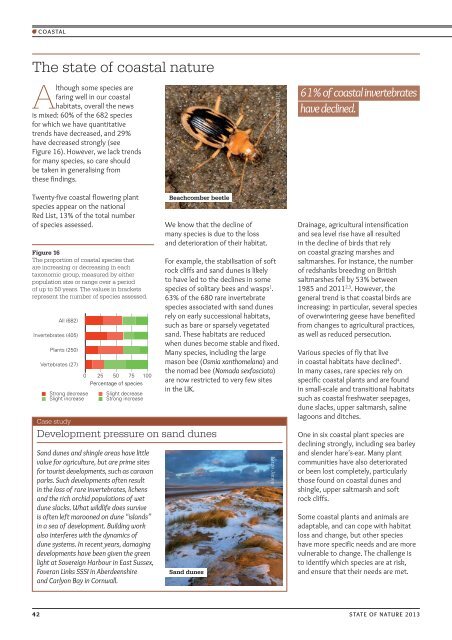State of Nature report - RSPB
State of Nature report - RSPB
State of Nature report - RSPB
Create successful ePaper yourself
Turn your PDF publications into a flip-book with our unique Google optimized e-Paper software.
COASTAL<br />
<br />
lthough some species are<br />
faring well in our coastal<br />
habitats, overall the news<br />
is mixed: 60% <strong>of</strong> the 682 species<br />
for which we have quantitative<br />
trends have decreased, and 29%<br />
have decreased strongly (see<br />
Figure 16). However, we lack trends<br />
for many species, so care should<br />
be taken in generalising from<br />
these findings.<br />
<br />
61% <strong>of</strong> coastal invertebrates<br />
have declined.<br />
Twenty-five coastal flowering plant<br />
species appear on the national<br />
Red List, 13% <strong>of</strong> the total number<br />
<strong>of</strong> species assessed.<br />
<br />
<br />
<br />
<br />
<br />
<br />
<br />
All (682)<br />
Invertebrates (405)<br />
Plants (250)<br />
Vertebrates (27)<br />
Strong decrease<br />
Slight increase<br />
0 25 50 75 100<br />
Percentage <strong>of</strong> species<br />
Slight decrease<br />
Strong increase<br />
<br />
We know that the decline <strong>of</strong><br />
many species is due to the loss<br />
and deterioration <strong>of</strong> their habitat.<br />
<br />
<br />
Sand dunes and shingle areas have little<br />
value for agriculture, but are prime sites<br />
for tourist developments, such as caravan<br />
parks. Such developments <strong>of</strong>ten result<br />
in the loss <strong>of</strong> rare invertebrates, lichens<br />
and the rich orchid populations <strong>of</strong> wet<br />
dune slacks. What wildlife does survive<br />
is <strong>of</strong>ten left marooned on dune “islands”<br />
in a sea <strong>of</strong> development. Building work<br />
also interferes with the dynamics <strong>of</strong><br />
dune systems. In recent years, damaging<br />
developments have been given the green<br />
light at Sovereign Harbour in East Sussex,<br />
Foveran Links SSSI in Aberdeenshire<br />
and Carlyon Bay in Cornwall.<br />
For example, the stabilisation <strong>of</strong> s<strong>of</strong>t<br />
rock cliffs and sand dunes is likely<br />
to have led to the declines in some<br />
species <strong>of</strong> solitary bees and wasps 1 .<br />
63% <strong>of</strong> the 680 rare invertebrate<br />
species associated with sand dunes<br />
rely on early successional habitats,<br />
such as bare or sparsely vegetated<br />
sand. These habitats are reduced<br />
when dunes become stable and fixed.<br />
Many species, including the large<br />
mason bee (Osmia xanthomelana) and<br />
the nomad bee (Nomada sexfasciata)<br />
are now restricted to very few sites<br />
in the UK.<br />
<br />
<br />
Drainage, agricultural intensification<br />
and sea level rise have all resulted<br />
in the decline <strong>of</strong> birds that rely<br />
on coastal grazing marshes and<br />
saltmarshes. For instance, the number<br />
<strong>of</strong> redshanks breeding on British<br />
saltmarshes fell by 53% between<br />
1985 and 2011 2,3 . However, the<br />
general trend is that coastal birds are<br />
increasing: in particular, several species<br />
<strong>of</strong> overwintering geese have benefited<br />
from changes to agricultural practices,<br />
as well as reduced persecution.<br />
Various species <strong>of</strong> fly that live<br />
in coastal habitats have declined 4 .<br />
In many cases, rare species rely on<br />
specific coastal plants and are found<br />
in small-scale and transitional habitats<br />
such as coastal freshwater seepages,<br />
dune slacks, upper saltmarsh, saline<br />
lagoons and ditches.<br />
One in six coastal plant species are<br />
declining strongly, including sea barley<br />
and slender hare’s-ear. Many plant<br />
communities have also deteriorated<br />
or been lost completely, particularly<br />
those found on coastal dunes and<br />
shingle, upper saltmarsh and s<strong>of</strong>t<br />
rock cliffs.<br />
Some coastal plants and animals are<br />
adaptable, and can cope with habitat<br />
loss and change, but other species<br />
have more specific needs and are more<br />
vulnerable to change. The challenge is<br />
to identify which species are at risk,<br />
and ensure that their needs are met.<br />
42 STATE OF NATURE 2013

















